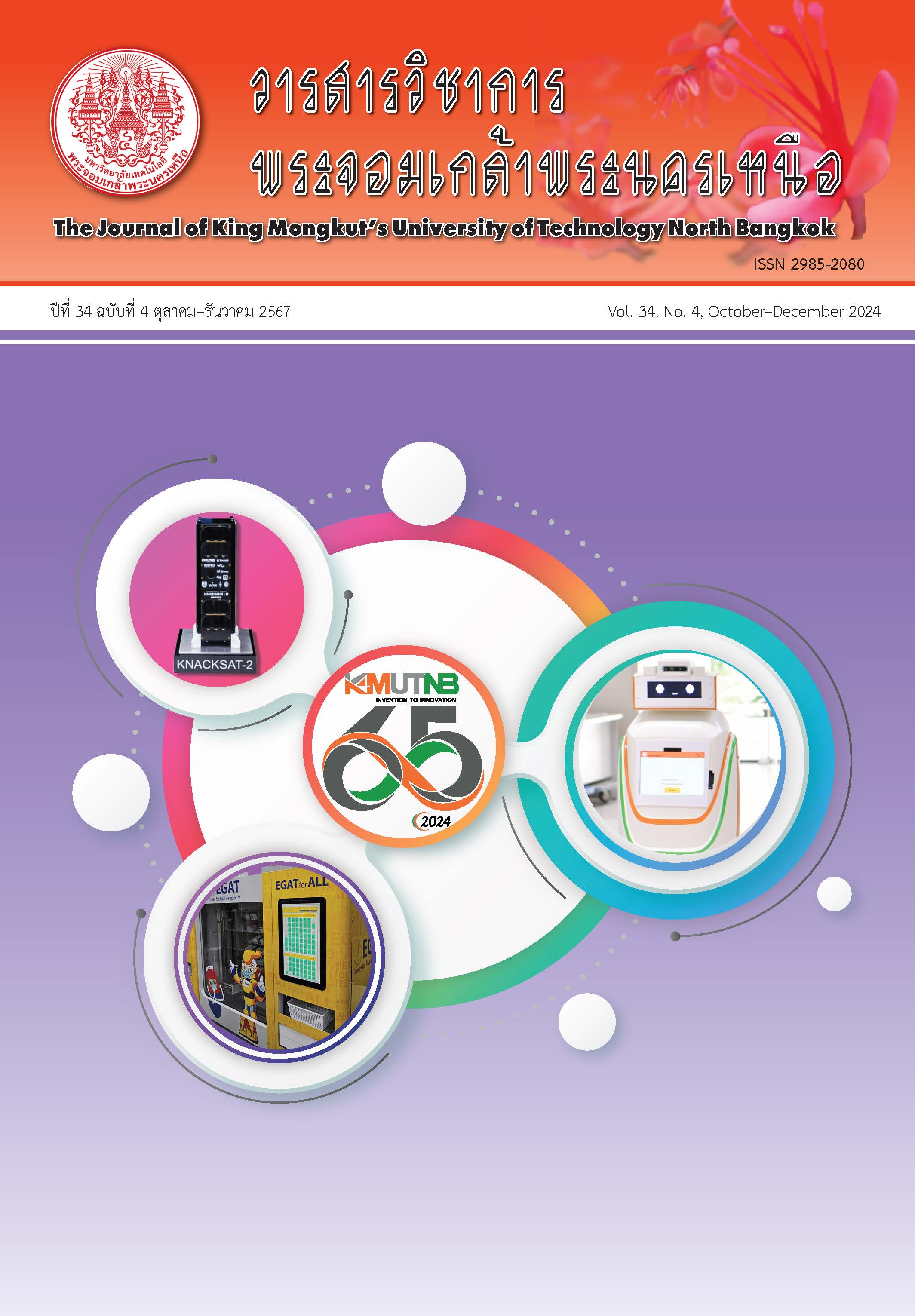Biogas Production from Pineapple Industry Wastewater Using UASB with Microbial Immobilization from Shrimp Pond Sludge
Main Article Content
Abstract
Agricultural industrial wastewater contains high organic loading from a production process, which is the main problem of environmental pollution in case it leaks to an open landfill or water resources. This research aims to propose a method of reducing organic content and converting wastewater into renewable energy. The Upflow Anaerobic Sludge Blanket (UASB) system was designed and established for biogas production and biological wastewater treatment from the agricultural industry waste. A suitable condition for biogas production from pineapple industry wastewater was performed and investigated and then applied in the designed UASB system. The result showed that the fermentation condition for submerging CAC (Cray/Activated Carbon) with microbial immobilization from shrimp pond sludge enhanced biogas production to 2.6 times and treated wastewater at the same time. The designed system reduced the COD value of wastewater and also produced biogas in a satisfactory way with approximately 24.74% of methane. Therefore, the application of the designed UASB system reveals the possibility and promising way of biogas production from pineapple wastewater.
Article Details

This work is licensed under a Creative Commons Attribution-NonCommercial-NoDerivatives 4.0 International License.
The articles published are the opinion of the author only. The author is responsible for any legal consequences. That may arise from that article.
References
F. Xu, Y. Li, X. Ge, L. Yang, and Y. Li, “Anaerobic digestion of food waste – Challenges and opportunities,” Bioresource Technology, vol. 247, pp. 1047–1058, 2018.
A. Nielfa, R. Cano, and M. Fdz-Polanco, “Theoretical methane production generated by the co-digestion of organic fraction municipal solid waste and biological sludge,” Biotechnology Reports, vol. 5, pp. 14–21, 2015.
I. Angelidaki, D. Karakashev, D. J. Batstone, C. M. Plugge, and A. J. M. Stams, “Biomethanation and its potential,” Methods in Enzymology, vol. 494, pp. 327–351, 2011.
A. Nopparat. (2015). Biogas production technology. Excellent Center of Waste Utilization and Management. King Mongkut's University of Technology Thonburi. Bangkok, Thailand [Online] (in Thai).Available: http://reg3.diw. go.th/safety/wp-content/uploads/2015/02/ KMforIDW_ADtech.pdf
L. Nimtrakul and S. Kanchanawong. (2022). What is the UASB process, what are its components, advantages and limitations. PAPOP. Bangkok, Thailand [Online] (in Thai). Available: https:// papop.com/กระบวนการ-uasb-คืื ออะไร/
Department of Alternative Energy Development and Efficiency. (2022). Industrial Biogas Production. Ministry of Energy. Bangkok, Thailand. [Online] (in Thai). Available: https://webkc.dede.go.th/ testmax/node/190
M. F. Jamaluddin, N. Zainol, and N. S. A. Mohd Sharif, “Troubleshooting on biogas production by using factorial analysis in sewage treatment plant (STP),” in Innovative Manufacturing, Mechatronics & Materials Forum 2020, 2021, pp. 1755–1762.
K. Khanthong, C. W. Purnomo, W. Daosud, and Y. Laoong-u-thai, “Microbial diversity of marine shrimp pond sediment and its variability due to the effect of immobilized media in biohydrogen and biohythane production,” Journal of Environmental Chemical Engineering, vol. 9, no. 5, pp. 106166, 2021.
C. E. Boyd, A. A. McNevin, R. P. Davis, R. Godumala, and A. B. C. Mohan, “Production methods and resource use at Litopenaeus vannamei and Penaeus monodon farms in India compared with previous findings from Thailand and Vietnam,” Journal of the World Aquaculture Society, vol. 49, no. 3, pp. 551–569, 2018.
M. Lesteur, V. Bellon-Maurel, C. Gonzalez, E. Latrille, J. M. Roger, G. Junqua, and J. P. Steyer, “Alternative methods for determining anaerobic biodegradability: A review,” Process Biochemistry, vol. 45, no. 4, pp. 431–440, 2010.
J. Xue, S. Schiano, W. Zhong, L. Chen, and C.-Y. Wu, “Determination of the flow/no-flow transition from a flat bottom hopper,” Powder Technology, vol. 358, pp. 55–61, 2019.
I. J. Dioha, C. H. Ikeme, T. Nafi’u, N. I. Soba and M. B. S. Yusuf, “Effect of carbon to nitrogen ratio on biogas production,” International Research Journal of Natural Sciences, vol. 1, no. 3, pp. 1–10, 2013.
S. Xu, C. He, L. Luo, F. Lü, P. He, and L. Cui, “Comparing activated carbon of different particle sizes on enhancing methane generation in upflow anaerobic digester,” Bioresource technology, vol. 196, pp. 606–612, 2015.
Y. Liu, C. Lin, H. Jia, X. Yong, X. Xie, X. Wu, J. Zhou, and P. Wei, “Effects of amino-modified biofilm carriers on biogas production in the anaerobic digestion of corn straw,” Environmental Technology, vol. 41, no. 21, pp. 2806–2816, 2020.
T. Bunbang, W. Kasetsongkram, and R. Nirunsin, “The study of biogas production from treatment waste water of thai rice vermicelli process by effective microorganism (EM),” in 12th Conference on Energy Network of Thailand, 2015, pp. 740–747 (in Thai).
S. Winitchai, W. Wirojanagud, S. Sinsupan, and A. Yimtae, “Anaerobic contact process for treating synthetic slaughterhouse wastewater,” KKU Research Journal, vol. 2, pp. 1–11, 2002 (in Thai).
T. Cheunbarn, S. Cheunbarn, M. Srikanlayanukul, R. Kawaree, and N. Khampa, “Appropriate ratio of swine waste and napier grass silage by fermented lactobacillus pantarump 107 for methane production,” Maejo University, Chiang Mai, Thailand, 2017 (in Thai).
B. Sialve, N. Bernet, and O. Bernard, “Anaerobic digestion of microalgae as a necessary step to make microalgal biodiesel sustainable,” Biotechnology Advances, vol. 27, no. 4, pp. 409–416, 2009.
C. Mao, Y. Feng, X. Wang, and G. Ren, “Review on research achievements of biogas from anaerobic digestion,” Renewable and Sustainable Energy Reviews, vol. 45, pp. 540–555, 2015.
Widyarani, Y. Victor, L. Sriwuryandari, E. A. Priantoro, T. Sembiring, and N. Sintawardani, “Influence of pH on biogas production in a batch anaerobic process of tofu wastewater,” in IOP Conference Series: Earth and Environmental Science, 2018, pp. 012014.

